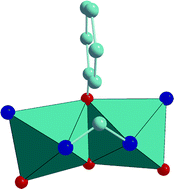Dinuclear nickel complexes with a Ni2O2 core: a structural and magnetic study
Abstract
The acetylacetonate complexes [Ni2L1(acac)(MeOH)]·H2O, 1·H2O and [Ni2L3(acac)(MeOH)]·1.5H2O, 2·1.5H2O (H3L1 = (2-(2-hydroxyphenyl)-1,3-bis[4-(2-hydroxyphenyl)-3-azabut-3-enyl]-1,3-imidazolidine and H3L3 = (2-(5-bromo-2-hydroxyphenyl)-1,3-bis[4-(5-bromo-2-hydroxyphenyl)-3-azabut-3-enyl]-1,3-imidazolidine) were prepared and fully characterised. Their crystal structures show that they are dinuclear complexes, extended into chains by hydrogen bond interactions. These compounds were used as starting materials for the isolation of the corresponding [Ni2HLx(o-O2CC6H4CO2)(H2O)]·nMeOH and [Ni2HLx(O2CCH2CO2)(H2O)]·nH2O dicarboxylate complexes (x = 1, 3; n = 1–3). The crystal structures of [Ni2HL1(o-O2CC6H4CO2)(H2O)]·MeOH, 3·MeOH, [Ni2HL3(o-O2CC6H4CO2)(H2O)]·3MeOH, 4·3MeOH and [Ni2HL1(O2CCH2CO2)(H2O)]·2.5H2O·0.25MeOH·MeCN, 5·2.5H2O·0.25MeOH·MeCN, were solved. Complexes 3–5 show dinuclear [Ni2HLx(dicarboxylate)(H2O)] units, expanded through hydrogen bonds that involve carboxylate and


 Please wait while we load your content...
Please wait while we load your content...